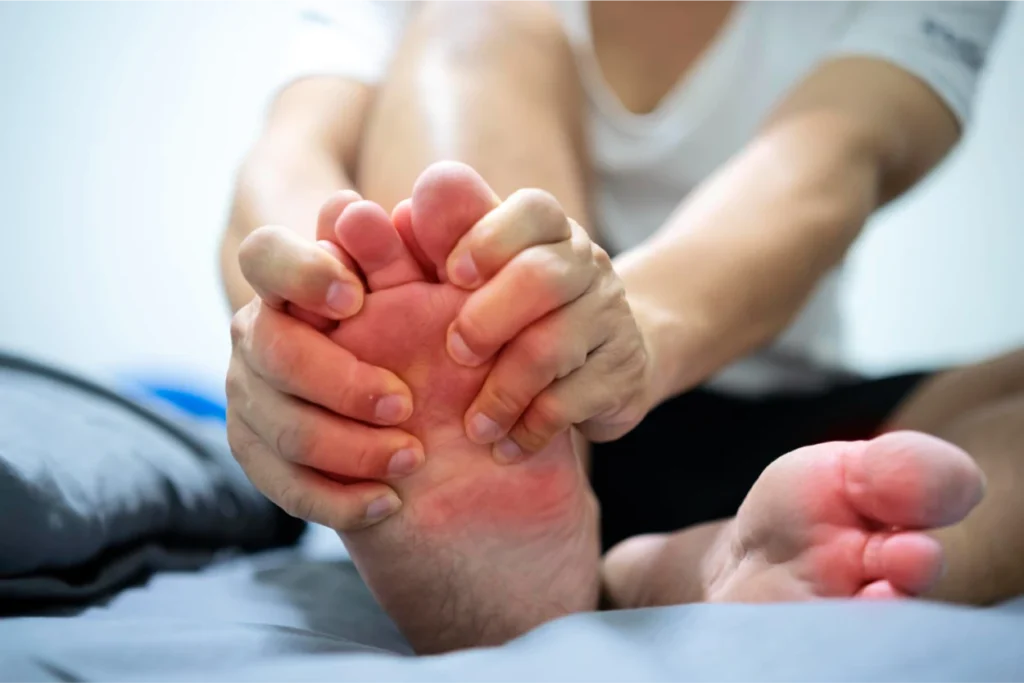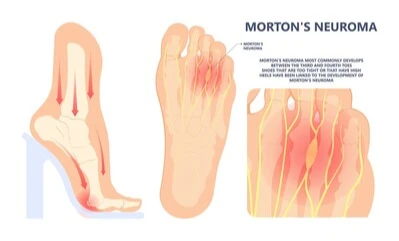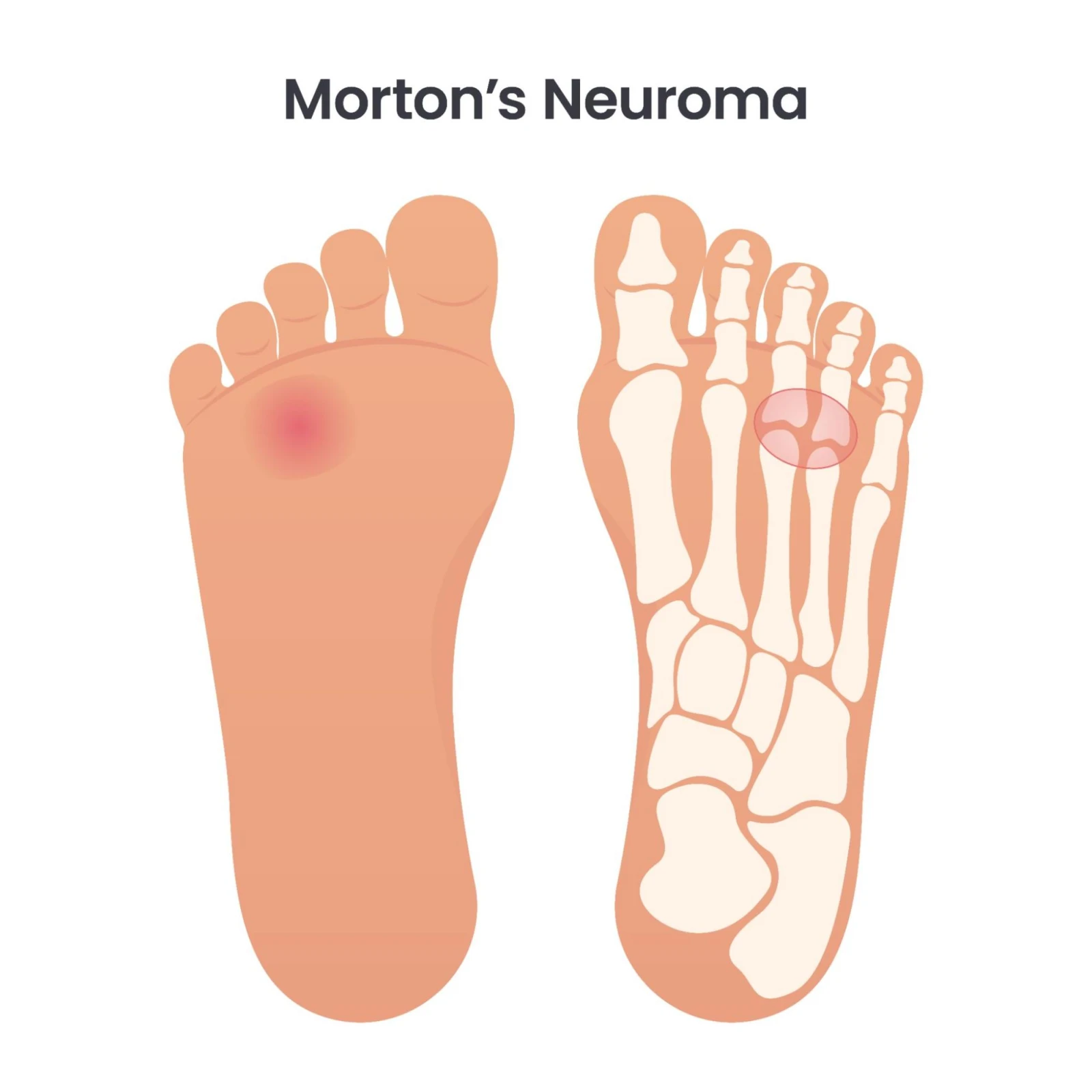Morton’s Neuroma is a condition that flies under the radar for many, despite its prevalence among around 30% of Americans. It’s a pesky foot ailment that often exhibits symptoms such as a burning sensation between your toes or the feeling of a pebble lodged within your shoe. To help you identify this condition, we’ve compiled a list of 10 signs you may have Morton’s Neuroma.
- Understanding Morton’s Neuroma Key Signs and Symptoms
- What Does Morton’s Neuroma Feel Like?
- 1. The sensation of a small stone in your shoe
- 2. Burning feeling in your foot
- 3. Pain or swelling
- 4. Tingling or numbness
- 5. Cramping toes
- 6. Pain when walking
- 7. Irritation from certain footwear
- 8. Pain when lifting up onto your toes
- 9. Spreading of the toes
- 10. Change in activity levels
- Morton’s Neuroma: A Closer Look
- Who’s at Risk?
- Home Remedies for Morton’s Neuroma
- When Surgery is Necessary
- When to Seek Medical Help for Pain
Understanding Morton’s Neuroma Key Signs and Symptoms
What Does Morton’s Neuroma Feel Like?

Morton’s Neuroma can manifest itself in various ways, with symptoms typically internal and sometimes tricky to diagnose without the aid of an orthopedic specialist. Here’s what Morton’s Neuroma might feel like
1. The sensation of a small stone in your shoe
If you constantly feel like you’re stepping on a tiny pebble or a folded sock, this could be a signal of Morton’s Neuroma.
2. Burning feeling in your foot
A common symptom is a burning sensation in the ball of your foot, particularly between your fourth and fifth toes.
3. Pain or swelling
These symptoms, especially if they worsen over time, could indicate the presence of Morton’s Neuroma.
4. Tingling or numbness
If you’re experiencing these sensations in your toes or the ball of your foot, you should take note.
5. Cramping toes
If your toes often cramp up, and you feel a need to massage the affected area, it could be a sign.
6. Pain when walking
Difficulty walking or experiencing pain when doing so is another symptom.
7. Irritation from certain footwear
If your pain intensifies when wearing high heels or shoes with narrow, pointed toes, you might have Morton’s Neuroma.
8. Pain when lifting up onto your toes
If you experience pain in the balls of your feet when you lift up onto your toes, it’s a potential sign.
9. Spreading of the toes
The toes closest to the painful area may start to spread.
10. Change in activity levels
A need to modify your activity levels due to persistent or worsening pain could be a sign of the condition.
Morton’s Neuroma: A Closer Look

Despite its name, Morton’s Neuroma is not a tumor. It’s a condition marked by the thickening of the nerve due to repeated pressure, irritation, or inflammation, typically affecting the ball of the foot between the fourth and fifth toes.
Who’s at Risk?
Certain individuals are more susceptible to Morton’s Neuroma due to factors such as:
- Foot deformities like flat feet, high arches, bunions, or hammertoes
- Participating in high-impact sports that put repeated pressure on the balls of your feet, like tennis or basketball
- Wearing high heels or shoes with narrow, pointy toes
Home Remedies for Morton’s Neuroma

While it’s crucial to consult a podiatrist for a definitive diagnosis and treatment plan, there are a few measures you can take at home to alleviate the symptoms of Morton’s Neuroma:
- Switch to comfortable shoes with a wide toe box
- Rest your feet and massage them after a long day
- Use an ice pack on sore areas to help with pain and swelling
- Stay fit, as excess body weight can worsen your condition
- Consider dietary changes, focusing on anti-inflammatory foods
Some people swear by home remedies like Morton’s Neuroma apple cider vinegar treatments and Epsom salt foot soaks. However, it’s best to consult your podiatrist about these options.
When Surgery is Necessary
In severe cases, surgery may be required to remove the irritated nerve(s). Typically, this involves a small incision on the top of your foot, and sometimes, the release of tight ligaments in the surrounding area. However, recovery from Morton’s Neuroma surgery is usually relatively quick, often within two to four weeks.
When to Seek Medical Help for Pain
If you’re experiencing foot pain that lasts longer than a few days, it’s best not to ignore it. If you notice any of the described symptoms or pain in your toes or the ball of your foot that’s not improving despite changes in shoes or activities, it’s time to consult a professional.
If you’re experiencing any of these 10 signs you may have Morton’s Neuroma, don’t hesitate to contact Victoria Foot and Ankle to schedule a podiatry consultation. We’re ready to help you get back on your feet and back to living your life…pain-free!








